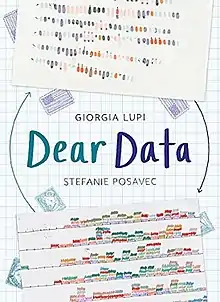Dear Data
Dear Data is a collection of postcards containing data recorded from the everyday lives of information designers Stefanie Posavec and Giorgia Lupi. The book was published in the United Kingdom by Penguin Press on September 1, 2016[1] and in North America by Princeton Architectural Press on September 6, 2016.[2]
 First edition | |
| Author | Stefanie Posavec, Giorgia Lupi |
|---|---|
| Language | English |
| Subject | Information design |
| ISBN | 978-1-84614-906-1 (Flexibound) |
Prior to this year-long collaboration, the co-authors had only met twice.[3] The premise of this project was to test firsthand how well one could get to know someone through reading their data. Postcards were exchanged between them on a weekly basis with the data being represented through a drawing on one side and a detailed key or legend on the other. A few of the topics include: A Week of Negative Thoughts, A Week of A Workspace, and A Week of New Things.[4] The project has surface similarities with the quantified self projects like designer Nicholas Felton's annual reports that quantify and represent life events like number of books read or place visited, but is more personal and less analytical, with hand-drawn illustrations replacing computer generated charts.[5][6] It "paints a human portrait with data." [7] Dear data is also, in a way, the opposite of Big Data, it is composed of representations little data about on the minutiae of individuals' lives.
The original post cards as well as several accompanying notebooks are now part of the permanent collection at the MoMa.[8][9]
Reception
Dear Data won two 2015 Information is Beautiful Awards, the Most Beautiful Award as well as Gold in the Dataviz Project category.[8] It was also a finalist for the Innovation By Design Awards 2016 and nominated for the Design Museum Beazley Designs of the Year 2016.[10] While the book was not widely reviewed, reviewers were generally positive.[11][7][3][12] Wired called the book "charming", saying it is "filled with hand drawn postcards and full-page spreads with insights about how it feels to keep a microscope on your life for an entire year."[5] It averages over four (out of five) stars in its more than seven hundred reviews on the social reading site Goodreads.[13]
References
- "Dear Data". Penguin Press. Archived from the original on 2 April 2020. Retrieved 2 April 2020.
- "Dear Data". Princeton Architectural Press. Archived from the original on 30 March 2019. Retrieved 2 April 2020.
- Davis, Nicola (21 August 2016). "Can you get to know a person through data alone?". The Guardian. Archived from the original on 13 April 2019. Retrieved 2 April 2020.
- Davis, Nicola (2016-08-21). "Can you get to know a person through data alone?". the Guardian. Retrieved 2018-03-10.
- Stinson, Liz (1 September 2016). "Here's What Happens When Two Designers Speak Only in Infographics". Wired. Archived from the original on 13 February 2019. Retrieved 2 April 2020.
- Sorapure, Madeleine (2019). "Getting Personal: Teaching Personal Writing in the Digital Age". Biography. 42 (2): 404. doi:10.1353/bio.2019.0040. S2CID 203381733 – via Gale Literature Resource Center.
- Silverberg, David (11 September 2016). "'Dear Data': a portrait of the data points that create a life". Seattle Times. Archived from the original on 1 February 2018. Retrieved 2 April 2020.
- "2015 winners Dear Data featured in MOMA's permanent collection — Information is Beautiful Awards". www.informationisbeautifulawards.com. Retrieved 2018-03-10.
- "Giorgia Lupi, Stefanie Posavec: Dear Data". MoMA. 2015. Archived from the original on 18 December 2019. Retrieved 2 April 2020.
- "Giorgia Lupi | Design Indaba". Design Indaba. Retrieved 2018-03-10.
- "Nonfiction Reviews: Dear Data". Publisher's Weekly. 263 (28). 11 July 2016. ProQuest 1803832949.
- Hess, Liam (28 September 2016). "Dear Data: The designers who turned daily habits into art". Culture. Archived from the original on 19 January 2019. Retrieved 2 April 2020.
- "Dear Data". Goodreads. Retrieved 2 April 2020.